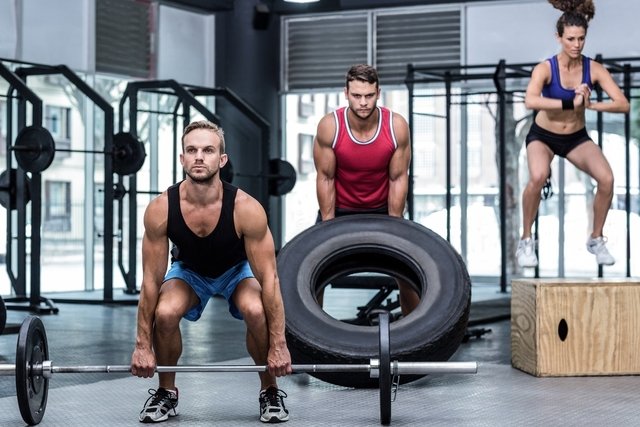Crossfit is a sports modality that has the benefits of promoting improved cardiorespiratory capacity, physical conditioning and muscular endurance through a combination of functional and aerobic exercises, which are performed at high intensity.
Furthermore, practicing CrossFit also increases muscle mass gain and guarantees more muscle strength and definition, in addition to promoting the health of the body and mind, as there is a constant production and release of hormones related to the feeling of well-being.
It is important that Crossfit is carried out under the guidance of a physical education professional, taking into account the physical conditions and limitations of the body, on an individual basis, to avoid any type of injury. In addition, it is recommended to consult a cardiologist to assess cardiovascular health, as high-intensity exercises are performed.

10 benefits of Crossfit
The main benefits of CrossFit are:
- Improve physical conditioning;
- Improve cardiorespiratory capacity;
- Define and tone muscles;
- Strengthen and increase muscular resistance;
- Increase to lean mass;
- Promote fat loss;
- Prevent injuries due to increased muscle mass;
- Reduce stress and/or anxiety;
- Promote a feeling of well-being and increased self-esteem;
- Strengthen the immune system.
Furthermore, Crossfit encourages team spirit, as training is carried out in groups, allowing stimulation and encouragement between people who perform the same training.
Who can do
Crossfit can be practiced by everyone, regardless of age and physical conditioning, however, it is important that before starting the practice, a cardiologist is consulted to assess the health of the heart and circulatory system and medical examinations are carried out to check if the person has any contraindications.
If you want to practice CrossFit, make an appointment with a cardiologist in the nearest region:
Taking care of your health has never been easier!
Crossfit exercises are performed progressively, that is, sedentary people and physically active people who have never practiced Crossfit start the exercises with little or no load with the aim of promoting the body’s adaptation to movement and avoiding muscle injuries.
As training is carried out and movements are perfected, more load is added with the aim of making the training more intense and ensuring more benefits.
How to do crossfit training
Crossfit workouts last an average of 1 hour and are normally divided into three parts, which are done as follows:
1. Warm up
O aheating corresponds to the initial part of the crossfit training and aims to warm up the muscles and prepare them for the training that will be carried out, preventing the occurrence of injuries.
The CrossFit warm-up exercises must be done with guidance from the physical educator, activating the muscles that will be used during the CrossFit exercises.
Therefore, you should warm up with mobility, stretching and flexibility exercises, as well as activating the cardiovascular system, such as jumping jacks, for example. See how to do mobility exercises and jumping jacks correctly.
2. Dynamic stretching
Dynamic stretching is done after warming up, and also aims to activate muscle fibers before starting CrossFit exercises and increase flexibility, avoiding joint injuries.
In dynamic stretching, movements such as rotation of arms, legs and hips are made, for example, and loads can also be used so as not to compromise the technique.
3. Workout of the day
No workout of the daypopularly known as WOD, the previously worked exercises are performed, but at a greater intensity and in a pre-established time.
This is the time when the intensity of the training is greater and allows for more benefits, as the objective is to carry out the training determined by the instructor, which consists of several series of exercises performed, in the shortest possible time and with little or no break between exercises. exercises.
Some examples of workout of the day are barbell deadlifts, push-ups, weighted squats, box jumps known as box jumpthrowing a ball at the wall also called wall balls or racing, for example.
Care when doing crossfit
Some precautions are important when doing CrossFit, such as:
- Consult a cardiologist to assess your heart health before starting CrossFit;
- Carry out a physical assessment with a physical education professional before starting training, to assess musculoskeletal conditions, as well as mobility;
- Perform the exercises under the guidance of a certified instructor;
- Start exercising less intensely and increase frequency and intensity over time, depending on physical conditions;
- Perform exercise movements correctly to avoid injuries;
- Use the amount of weights recommended by the physical education professional;
- Warm up and dynamic stretch before starting the workout. workout of the day;
- Respect your own body’s limits, and stop exercising if you feel pain or think you are using excessive weight;
- Include rest days between workouts, for muscle recovery, and it is recommended to do CrossFit 2 to 3 times a week, with rest between training days.
Furthermore, to obtain maximum benefits from CrossFit, it is important that the diet is appropriate to the type of physical activity performed and caloric expenditure, and it is recommended that the dietary plan be created by a nutritionist according to the person’s nutritional needs. See what nutrition should be like for CrossFit practitioners.
Crossfit risks
Despite having several health benefits, Crossfit can cause muscle, tendon, ligament or joint injuries, such as shoulders, back, knees, elbows or wrists, for example, especially when done without guidance from a physical education professional, or performed incorrectly or with a load not appropriate for the person.
Furthermore, some studies show that inadequate CrossFit practice can lead to rhabdomyolysis, which is characterized by the destruction of muscle fibers, resulting in muscle pain, lack of strength and difficulty moving the legs or arms, for example. Understand what rhabdomyolysis is and how to identify it.

Sign up for our newsletter and stay up to date with exclusive news
that can transform your routine!
Warning: Undefined array key "title" in /home/storelat/public_html/wp-content/plugins/link-whisper-premium/templates/frontend/related-posts.php on line 12
Warning: Undefined array key "title_tag" in /home/storelat/public_html/wp-content/plugins/link-whisper-premium/templates/frontend/related-posts.php on line 13



